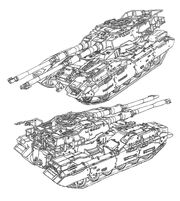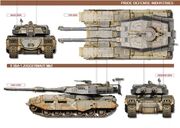| T-31 Juggernaut Mk1 | |
|---|---|
 Scale model of the T-31 | |
| Type | Main battle tank |
| Place of origin | Imperial Realm of the Pridelands |
| Service history | |
| In service | 2002-present |
| Used by | |
| Wars | Apartheid War |
| Production history | |
| Designer | Pride Defense Industries |
| Designed | 1999 |
| Manufacturer | Pride Defense Industries |
| Unit cost | est. $2.7 million |
| Produced | 2002-2000 |
| Number built | ~230 |
| Variants | See Variants |
| Specifications | |
| Weight | 50 tonnes |
| Length | 9 m (with gun) 7.3 m (hull only) |
| Width | 3.8 m |
| Height | 2.3 m |
| Crew | 4 (commander, driver, gunner, and loader) |
| Armor | Steel and composite armor in modular design |
| Primary armament |
2 x 115 mm smoothbore gun (36 rounds total) |
| Secondary armament |
1 x copula 14.5 mm HMG 2 x coaxial 7.62 mm GP MG 1 x pintle-mounted 5.56 mm LMG |
| Engine | 4-cycle, V-12 turbocharged air-cooled diesel engine 960 hp (720 kW) |
| Power/weight | 14.4 kW/t (19.4 hp/t) |
| Suspension | Torsion-bar |
| Ground clearance | 0.46 |
| Fuel capacity | 1,200 L |
| Operational range | 640 km |
| Speed | 63 km/h |
The T-30 tank design series is the first main battle tank design developed and produced domestically in the Imperial Realm of the Pridelands. It incorporated an unconventional twin main cannon armament to overcome the Olifant Mk.1A of the South African Defense Force. Work on the design was spearheaded by the Imperial Grand Ministry of War with principal funding from House Pride. The 2nd Engineering Battalion of the Imperial Sovereign Order of the Emperor's Guards developed the design and built the prototype as well as the first few batches of the T-31.
The T-30 design is still active with only the pioneering T-31 version being discontinued from production in 2000 to make way for the more advanced T-35 variant among others.
Background[]
After the Liberation War, the Imperial Realm has grown insecure of its ability to counter and neutralize a South African attack inland, especially with massed armor, where its naval prowess cannot provide support and covering fire.
During the Frontier Wars, such fears were realized as Olifant tank formations were positioned near the borders and were used in some battles and skirmishes when South Africa advanced through the border lines. The T-10 (domestic designation for the Soviet T-62) was the premier and only tank in usage within the Imperial Realm at the principal stages of the war and they proved ineffective and unrealiable to stop enemy tanks. The Imperial Grand Ministry of War sought to remedy the situation by procuring T-64s and early T-72s but the USSR wished not to directly supply a belligerent of a United States ally during wartime and stalled giving a decision on the request. Frustrated by this, the Emperor ordered for the domestic procurement of a suitable tank that can engage the Olifant. The 2d Engineering Brigade of the Imperial Sovereign Order of the Emperor's Guards was given the task of providing such equipment including developing a design, producing a prototype, and eventually even the task manufacturing it.
After the success of the design in field tests and the Frontier Wars, the Imperial Grand Ministry of War established the state-owned Pride Defense Industries, with House Pride having a majority stake in the company, who then took over the T-30 tank design series developing six other variants through the years.
Design[]

The T-30 Tank design series
The T-30 Tank design series revolves around three key principles: (1) overwhelming firepower, (2) crew safety & comfortableness, (3) ease for mass production.
To enable the T-30 to achieve overwhelming firepower, designers initially considered using a 100mm naval gun or making an indigenous 122mm tank gun but both options faced the limitations of too much costs and strained sources for procurement. Making use of scrapped 115mm tank guns scavenged from destroyed T-10s was deemed favorable but was realized not enough to beat Olifant armor. A suggestion came from the field sappers and active tank crews to mount two 115mm tank guns to primitively achieve enough firepower citing the tank tactical maneuver of firing upon enemy armored fighting vehicles in pairs. Due to a lack of time and pressure from the government to have field tests immediately, theoretical simulations of having dual tank guns were skipped; in lieu of such scientific tests, 3 prototypes were produced over less than four months. The T-30 prototypes, with T-21 escorts, were able to engage and collectively destroy 4 enemy Olifant tanks though one T-30 was destroyed and another heavily damaged.
History[]
The first combat the T-30 Tank design series had was during the late phases of the Frontier Wars. Four T-30 prototypes participated in a pursue-and-raid operation during the Battle of Tirona, the last battle to have tank warfare. Officially though, its participation is recorded as field tests and not as an engagement.
The T-31 MBT was extensively deployed during the Apartheid War with many military cliques citing its war contribution as critical. The T-32 Combat Support Tank, T-33 Sapper Tank, and T-34 Air Defense & Suppression Tank were all designed and manufactured during the war as well to augment particular circumstances in the battlefield.
Variants[]
T-31[]

T-31 MBT "Juggernaut Mk1"
The T-31 is the original production-version of the T-30 tank design series. Introduced in late 1989 with just small quantities, it was too late for it to fully participate and engage with their South African counterparts in the Frontier Wars of which it was principally developed for. The tank has been in active service from its introduction in 1989 until 2005. It is now in limited service only with a few Imperial Orders.
The T-31 is armed with double 115mm cannons that are each serviced by a 5-shell capacity revolver chamber.
T-32[]

T-32 Combat Support Tank
The T-32 is a combat support tank variant of the T-30 tank design series. It was designed to be deployed and engage in urban environments where MBTs have proven to be greatly restricted from using its power and mobility.
The T-32 is armed with double 76mm cannons, grenade launchers/mortars, smaller autocannons and machine guns, as well as a flamethrower.
T-33[]
The T-33 is a sapper tank variant of the T-30 tan design series. It is a tank equipped with the revolutionary Change Armor System (CAS) developed by Pride Defense Industries which allows the T-63 to have a wide array of equipment that can be attached and detached immediately under 5 minutes. It can fitted with a folding crane, anti-mine chain, bridge layer, etc. Despite being a specialized combat engineering tank, the T-33 is often also used as a self-propelled mortar carrier due to its armament by using the CAS to improve its combat durability and armor/secondary armament arrangement.
The T-33 is armed with double 120mm mortars.
T-34[]
Air Defense & Suppression Tank. Armed with double 57mm cannons.
T-35[]
| T-35A-1 Juggernaut Mk2 | |
|---|---|
 Scale model of the T-35A-1 | |
| Type | Main battle tank
|
| Place of origin | Imperial Realm of the Pridelands |
| Service history | |
| In service | 2002-present |
| Used by | |
| Wars | Apartheid War |
| Production history | |
| Designer | Pride Defense Industries |
| Designed | 1999 |
| Manufacturer | Pride Defense Industries |
| Unit cost | $3.9 million (Upgrade conversion) $4.3 million (Production) |
| Produced | 2002-2010 |
| Number built | 194 |
| Variants | See Variants |
| Specifications | |
| Weight | 62 tonnes |
| Length | 9 m (with gun) 7.3 m (hull only) |
| Width | 3.8 m |
| Height | 2.3 m |
| Crew | 3 (commander, driver, and gunner) |
| Armor | Steel and composite armor in modular design |
| Primary armament |
2 x 115 mm smoothbore gun (36 rounds total) 2-shot ATGM box launcher (optional) |
| Secondary armament |
1 x copula 14.5 mm HMG 2 x coaxial 7.62 mm GP MG 1 x pintle-mounted 5.56 mm LMG |
| Engine | 4-cycle, V-12 turbocharged air-cooled diesel engine 1,200 hp (895.5 kW) |
| Power/weight | 14.4 kW/t (19.4 hp/t) |
| Suspension | Torsion-bar |
| Ground clearance | 0.46 |
| Fuel capacity | 1,200 L |
| Operational range | 640 km |
| Speed | 63 km/h |

T-35A-1 MBT "Juggernaut Mk2"
Upgrade of the T-31 series original. One of the primary upgrades made is the installation of a new 3-shell capacity box magazine and a domestically-built auto loader that removes the need of a loader from the original T-30 series tank crew of four men. Armed with double 115mm cannons.
The T-35 can be procured either as an upgrade conversion of existing T-31s (designated as T-35B-1/2) or wholly produced as a new unit (designated as T-35A-1/2).
The T-35A-1 is the original production version while the T-35A-2 is a production version with an additionally equipped 2-shot ATGM launcher.
T-36[]
Artillery Support Tank. Armed with double 122mm cannons.

Proposed T-37 MBT "Juggernaut Mk3"
T-37[]
Further upgrade with advance equipment adopted from the T-60 series prototype. Armed with double 125mm cannons and can use guided missile rounds.
A-60[]
The I-60 is an 8x8 wheeled tank destroyer/heavy infantry fighting vehicle fitted with a specialized T-30 turret. Essentially it is the wheeled version of the T-30 Tank design series and is meant to provide combat support during operations in a tandem formation of T-30s and A-60s. It is mainly used in force reconnaissance missions though it lacks the capability to efficiently engage tanks.
The A-61 variant is armed with double 100mm or 115mm cannons; the A-62 with double 120mm mortars; the A-63 with double 30mm and anti-air missiles; the A-64 with double 57mm and anti-tank missiles; the A-65 with double 14.5mm HMGs or 20mm autocannon and 40mm automatic grenade launchers; the A-66 Medical Vehicle, A-67 Field Laborer, A-68 Fire Controller, and A-69 Mobile Command are all armed with secondary armament only.
It is slowly being phased out in favor of the A-90 8x8 wheeled heavy IFV/tank destroyer.
Operators[]
 Imperial Realm of the Pridelands - ~160 T-35s; >24 T-32s in active service; >36 T-33s in active service; ~76 T-34s; ~19 T-36s
Imperial Realm of the Pridelands - ~160 T-35s; >24 T-32s in active service; >36 T-33s in active service; ~76 T-34s; ~19 T-36s Imperial Union of the Proudlands - 20 T-31s; 12 T-35s, 8 more on order to be delivered by August 2015 in two batches.
Imperial Union of the Proudlands - 20 T-31s; 12 T-35s, 8 more on order to be delivered by August 2015 in two batches.
